Thinking about buying a vintage fountain pen but don’t know where to start? This guide will tell you everything you need to know.

Think of the last time you wrote something down. On paper. Can you recall what you wrote with– maybe a pen, a pencil, or perhaps even a tiny green crayon?
Straining to remember? Most people don’t take much thought as to what they write with.
That’s not a big deal when you’re writing down your signature on a grocery store receipt, but when you’re crafting a thank you note to someone you admire, or a love letter to your girlfriend, writing with a pen you got at the bank can seem somehow… inadequate.
Using a fountain pen can contribute towards making recording (and reading) the written word a memorable experience.
Purpose of this Guide
I got my first vintage fountain pen when I was about 15 years old. It was passed on to me after a relative found it among my grandfather’s things after he died.
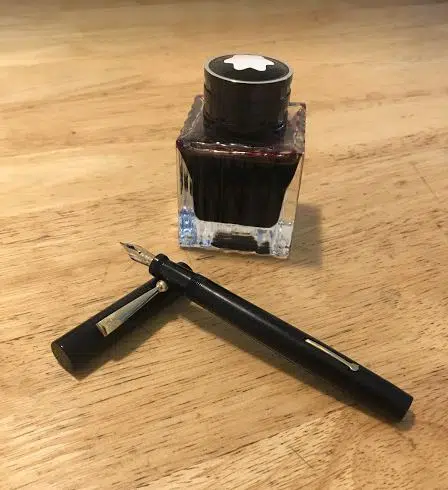
I faced a steep learning curve learning how to figure out, first, how to get my 1920’s “Moore” pen working and second, how to write with a vintage flex pen.
Now, with almost 10 years of accumulated knowledge about vintage pens, I’ve created this guide to outline things I wish I knew when I got my first vintage pen.
Why Write with a Vintage Fountain Pen?
Get a fountain pen if you want to slow down and appreciate the tactile experience of putting your thoughts to paper. Consider getting a vintage fountain pen for a unique and rewarding writing experience.
In my opinion, vintage fountain pens, pens that are 30+ years old, have more personality, and are therefore more enjoyable to use, than their modern descendants.
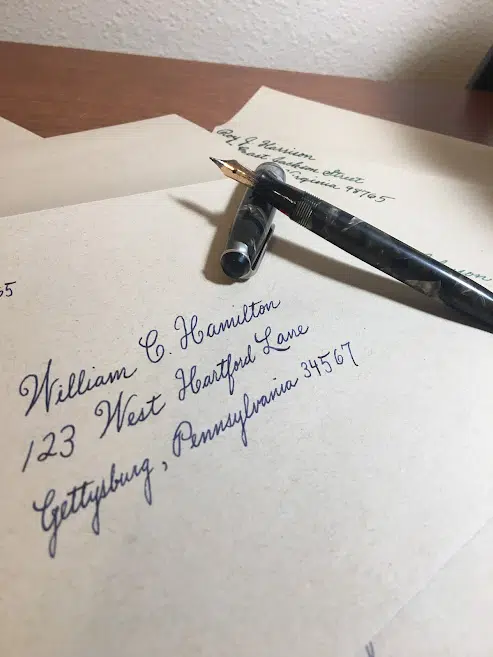
Most, but not all, modern pens tend to be made as statement pieces. In other words, they are basically jewelry first and a writing implement second. Vintage pens, on the other hand, were created before the advent and proliferation of personal computers with word processing capabilities.
They served as vital tools used in the workplace and in one’s personal correspondence. If they looked nice (and many of them are quite beautiful), that was a bonus.
Here are some other reasons people like vintage fountain pens.
Using a vintage fountain pen can:
- Enhance your handwriting.
- Bring novelty into a once mundane task
- Bring greater variety into your EDC
- Spark a new collection or hobby (read, “obsession”)
- Allow you to experiment writing with different inks
While I personally love writing with vintage fountain pens, I have to admit that they aren’t for everyone. If you can’t remember the last time you opted for writing with a pen on paper over a digital medium, you probably wouldn’t get much use for a vintage pen.
Then again, for many that’s part of their appeal– writing with a vintage pen is such a different writing experience from the impersonal, somewhat sterile experience of typing on a keyboard.
Buying a Vintage Fountain Pen: What to Look For
Before you start shopping for a vintage fountain pen, you need to know what you’re looking for.
Ideally, you should find a pen with a barrel free from damage (including hairline cracks), a working filling mechanism, and a nib (pen tip) that suits your style of writing. If possible, test out the pen before purchasing it.
More details on all of this below.
Fountain Pen Barrels
Don’t overlook the pen barrel when buying a vintage pen. Make sure there it doesn’t have any large chips or any cracks.
Barrel Materials
You can find vintage fountain pen bodies in a wide array of materials, including plastic, celluloid, hard chased rubbed (HCR), and metal. Don’t overthink this. It doesn’t really matter what material you choose.
Barrel Thicknesses and Length
Before buying a pen, consider what size pen you want. Some pens are really thick and fat, some are tall and thin. Get what you think you’d like. Test out a few different sizes in brick-and-mortar shops if possible.
Filling Mechanisms
In an effort to differentiate themselves from their competitors, back in the day fountain pen manufacturers came up with a variety of methods to fill fountain pens with ink.
Lever Fillers
Most vintage pens that I’ve come across are lever fillers. When you pull a tiny lever on the barrel of the pen an internal mechanism squeezes an ink bladder, filling the bladder full of ink through suction.
Button Fillers
Fill by twisting off a blind cap and pressing a button on the butt of the pen. Submerge the tip in ink and press the button 2-3 times. A tiny sac inside the pen will fill with ink.
Cartridge Pens
The vast majority of modern fountain pens take cartridges. You’ll see some vintage pens that use them too. Keep in mind that, depending on the vintage pen, it can be hard to source cartridges that fit.
Eyedroppers
The first fountain pens had to be filled using an eyedropper. As you can imagine, this makes filling inconvenient.
Other Filling Mechanisms
Other filling mechanisms include crescent fillers, pistons, and vacuumatics (the list goes on…).
If you aren’t sure what filling mechanism a pen employs, ask the seller or check online.
Nib Types
A nib is the tip of the pen– the part of the pen that actually spreads the ink on the page. Nibs have two tines separated by a tiny slit. Ink moves from the ink reservoir, down the feed, and through the slit onto the page through capillary action.
In my opinion, when you’re new to fountain pens, what material the nib is made out of isn’t very important. (That said, you’ll find that many vintage pens have nibs made out of the most desirable material– 14K gold).
Fountain pen aficionados have oodles of descriptors to distinguish minute differences between types of nibs. Here are just a few different types of nibs.
Nails
Recent initiates into the world of fountain pens take notice. Writing with a nail nib is going to be the most like writing with a ballpoint pen. This type of nib is rigid (like a nail) and doesn’t flex at all.
Flexible Nibs
Up until a few decades ago, most nibs were flexible to some degree. Flexible nibs spread their tines when pressure is applied, allowing the writer to create line variation.
Because writing styles have changed, few modern nibs are flexible.
Be aware that flex nibs can be fragile. If you press too hard you can “spring” the nib (i.e. permanently moving the tines out of alignment).
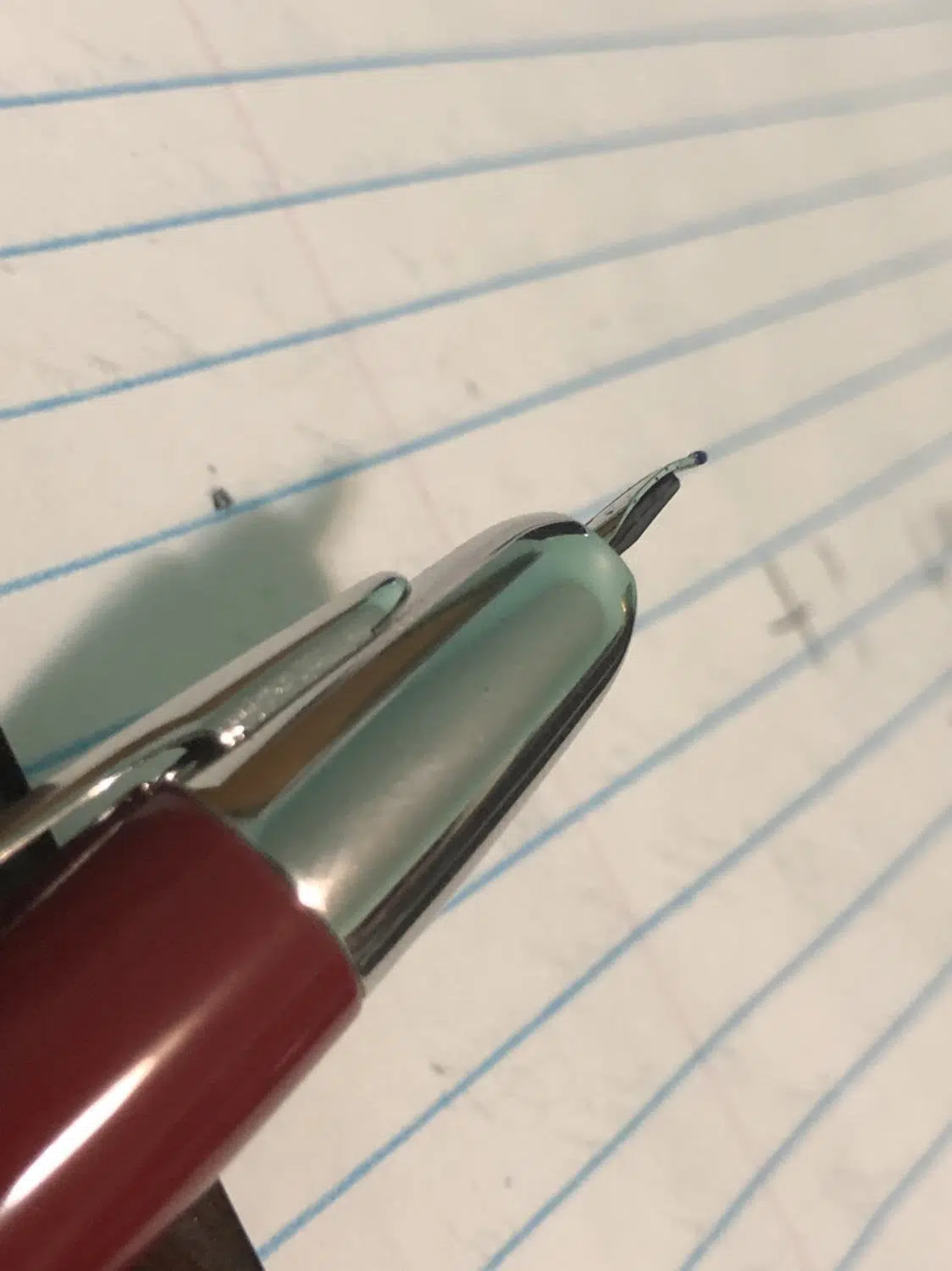
A pen that has a sprung nib is difficult (and sometimes impossible) to repair without replacing the nib.
Fun fact: Nibs range in flexibility from “nails” (no flex at all) to “wet noodles” (lots of flex with minimal pressure needed).
Hooded Nibs
Hooded nibs look different from regular nibs.
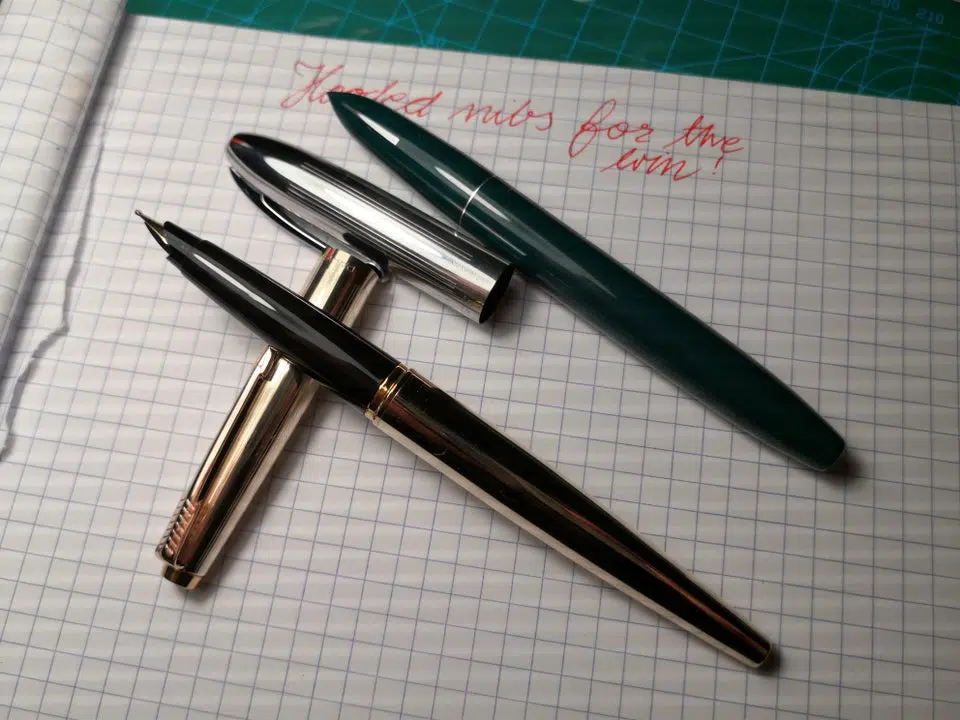
However, they don’t require any special technique to use.
Rounded Nibs vs Italic Nibs
There are many types of nib grinds. A nib grind refers to the shape of the tiny surface of the nib where the pen actually touches the paper.
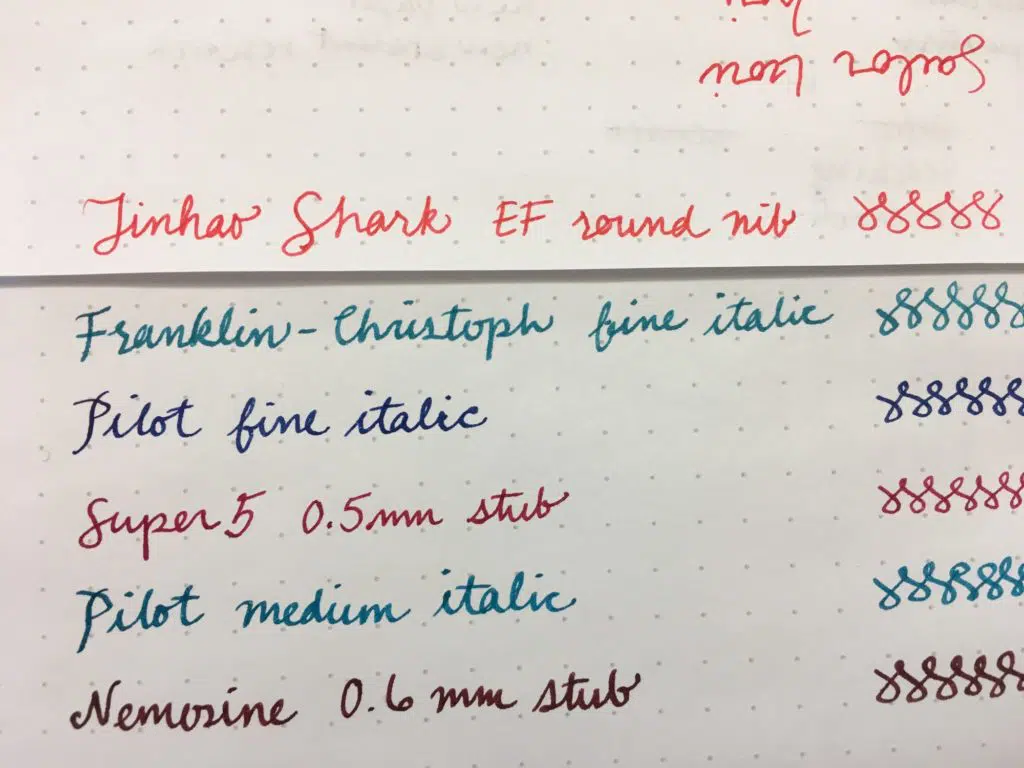
Rounded nibs are ideal for everyday writing. Italic nibs are great for people looking to make a bold statement with their everyday writing and for those that enjoy italic calligraphy.
While there are many types of specialty grinds, levels of nib flexibility, and nib materials, for most people who are looking to get their first fountain pen I’d recommend getting a fine (or medium) round nib with little to no flex.
Where to Buy a Vintage Fountain Pen
When you’re looking to get a vintage fountain pen, the first thing you should do is ask around. It’s likely that your grandparents, aunt, uncle, or old family friend has a fountain pen lying around that no one uses anymore.
I’ll go out on a limb and wager that, if you ask, they’d be more than happy to give it to you.
If you still can’t find a vintage pen or if you have a particular type or model in mind you’ll have to do some shopping.
While you can find vintage fountain pens for sale in flea markets, thrift stores, antique shops, and garage sales, you aren’t guaranteed to find old pens in any of these places. Your best bet is going to be buying a pen online or in a brick-and-mortar pen shop.
I think that the best places to buy vintage pens online is Ebay or from sites that specialize in selling vintage pens. In either case, make sure that they offer returns. You don’t want to be stuck with a dud.
Also, unless you want to go through the hassle of getting your pen repaired, be certain that the pen writes before paying up. Often vendors will say if it works in the product description. If you’re unsure, don’t hesitate to message them.
A specialty pen store will have experts that can help answer your questions. Check before you go to make sure that they carry vintage pens.
Choosing an Ink
A quick note about ink.
Pens may behave very differently depending on the ink you’re using. Some pens might write beautifully with an iron gall ink, another pen might perform very poorly with ink from the very same bottle.
It really does just depend on the individual pen.
However, just like how dog breeds have certain “personality tendencies,” certain brands or models will, as a general rule, work well with certain inks. Do a little research before buying ink.
Warning: Always use inks that are labeled for use in fountain pens. Never ink a fountain pen with India ink. It will destroy your pen.
How to Test a Vintage Fountain Pen
As I mentioned earlier, it is best to test a pen before buying it. If you are snooping around flea markets, you might even want to bring along your own paper and a small bottle of ink.
The first order of business is to ink the pen. If the filling mechanism doesn’t work, the pen still might be salvageable after the proper repairs. To test how the nib writes, you can dip the pen in a bottle of ink and write with it without filling its ink reservoir.
Write a few lines. Write large. Write small. Maybe do a few loops. To test if it is a flex nib put some pressure on the down strokes.
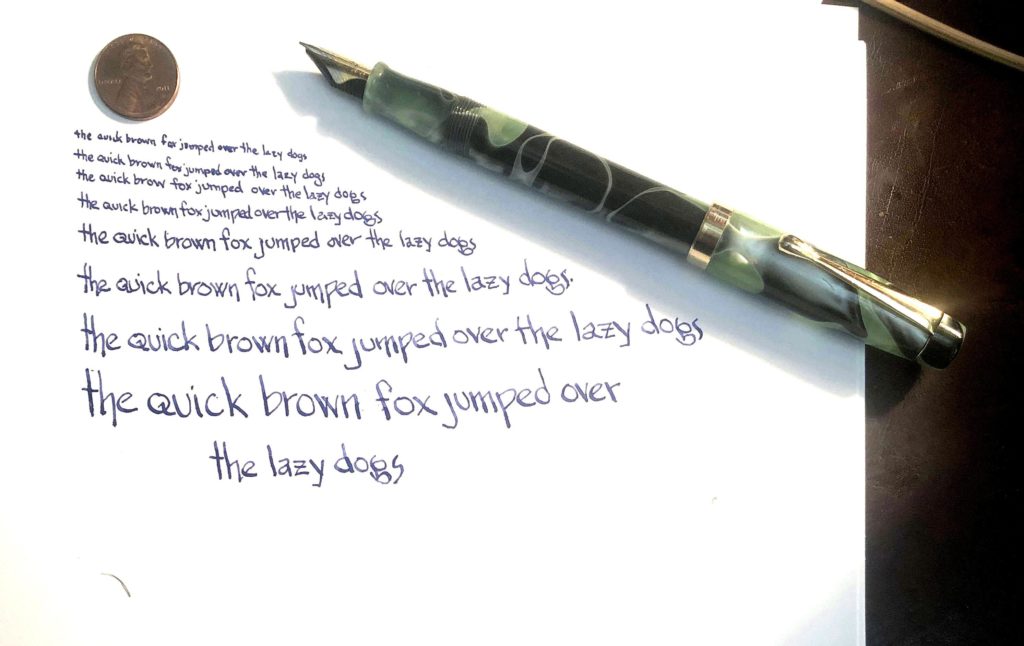
If the pen has trouble making a consistent line or it feels “scratchy” as you write, you probably want to pass. These problems can sometimes be fixed, but it’s best to get a pen that works well right off the bat.
Maintaining Your Pen
Fountain pens, especially older ones, have to be properly cared for. This can be frustrating.
“None of us can have as many virtues as the fountain-pen, or half its cussedness; but we can try.”
Mark Twain (Following the Equator)
However, if you get your pen repaired by a professional, flush out your pen every once and a while, and keep your pen safe from damage, they can be very reliable.
Flushing Your Pen
Every few months, or when you change inks, flush out your pen.
Do this by emptying any ink remaining in the pen and filling the pen with clean water. (Ideally you should use distilled water, but I just use room temperature tap water).
Using the filling mechanism, empty the water and repeat until the water being flushed out of the pen is clear. This will be “good enough” for most people, but there may be occasions in which you may want to flush out your pen more thoroughly (like if you are going to store it for a long time).
If you aren’t going to be using your pen for a while (more than say a week or so) be sure it isn’t inked. A fountain pen containing dried ink won’t write and will require expert knowledge to repair.
Lending Your Fountain Pen (Don’t Do It!)
I have to admit, I don’t let other people use my fountain pens. Even if they ask nicely.
The only exceptions I make are if I know that the person is familiar with writing with fountain pens, or if they want me to teach them.
This is not just because they might walk off with it. It won’t do them (or you) any good if they borrow your pen without knowing how to use it.
The average person doesn’t know how to write with a fountain pen and will, almost without fail, damage your pen. Of course, if you have time you could show them the ropes.
Tip: To avoid offending people by refusing to lend them a pen, carry a backup ballpoint or rollerball pen for borrowers.
Repairing Your Pen
Eventually, your pen will need to be repaired. The ink sac may rupture, the tines could become misaligned, or one of a dozen other problems can render your pen unusable. Vintage fountain pens can last for decades if you get them repaired when necessary.
Getting a vintage pen repaired can be tricky. You can try to do minor repairs yourself but beyond the basics like fixing that are slightly out of alignment and maybe replacing an ink bladder fountain pen repairs can be complicated. Also, depending on the pen, parts can be hard to come by.
You’d be best to mail your pen to an expert for repairs. The trouble is, there aren’t that many reputable fountain pen repairmen left in the world.
Do your research and try to find someone you can trust.
Conclusion
Vintage fountain pens are fun to use. They are also great conversation starters.
As I’ve repeated throughout this article, when it comes to vintage pens it is vital that you “do your research.” Armed with just a little bit of knowledge you can find, use, and maintain a tool that you can pass on to your grandkids. How cool is that?
Have you ever used a fountain pen? Tell us in the comments!

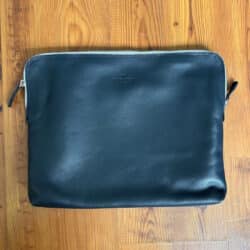
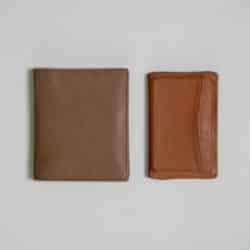
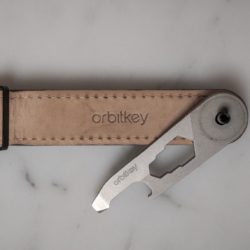
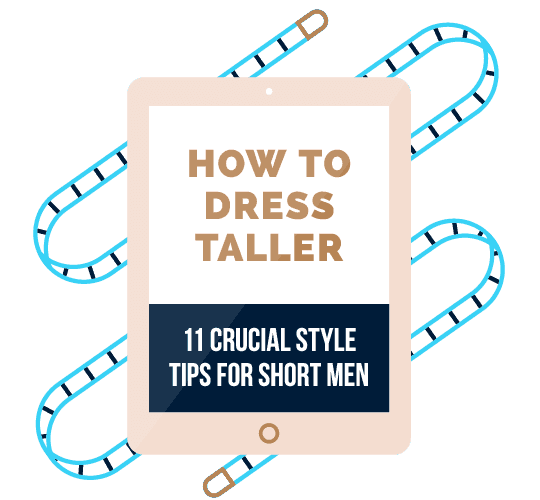

Where can I find a nib that writes dou,ble
Hi Hazel,
I think you’re looking for a “music nib.” Some music nibs, like this one, can write multiple lines. Is this the kind of thing you’re looking for? https://www.paperinkarts.com/bmusic.html?setCurrencyId=1&srsltid=AfAwrE7jv5dn3G8FIn265yiqAS8r1idUI-Wi35VS1XpwHvJ_nJ5vkZ_DO1g
Fantastic article! Very comprehensive and helpful!
Thanks Teri! I appreciate it.